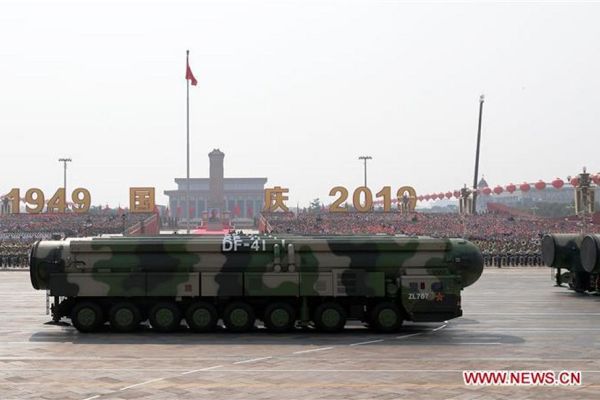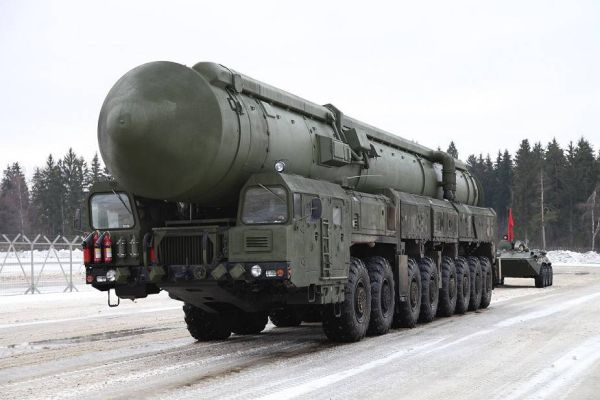ICBM Intercontinental ballistic missiles.
RS-26 Rubezh SS-X-31.

The RS-26 Rubezh is a Russian intercontinental ballistic missile (ICBM) system developed by the Moscow Institute of Thermal Technology (MITT). Designed as a road-mobile, solid-fueled platform, it combines advanced warhead technology with high mobility and survivability. The RS-26 is a derivative of the RS-24 Yars but features improvements in agility, rapid deployment, and the ability to counter advanced missile defense systems.
Country users: Russia
Description
The RS-26 Rubezh, meaning “Frontier” in Russian, is designated by NATO as SS-X-31. The missile is equipped with a MIRV (Multiple Independently Targetable Reentry Vehicle) system. This means the missile can carry several nuclear warheads, each capable of being directed to a different target. For example, the RS-26 can destroy multiple cities or military installations with one launch. Its advanced speed and maneuverability make intercepting difficult, ensuring it can deliver catastrophic damage to multiple strategic locations across continents. This road-mobile ICBM system represents a strategic advancement in Russia’s nuclear deterrence capabilities. Developed in the 2000s, it underwent its first successful test from the Plesetsk Cosmodrome on May 26, 2012, hitting a target at the Kura Range over 5,800 kilometers away. Additional successful tests followed, including launches from Kapustin Yar in 2015 to the Sary Shagan range in Kazakhstan.
The RS-26 was initially projected to enter service in 2016. However, its deployment was delayed in favor of the Avangard hypersonic glide vehicle program, though it remains a critical asset within Russia's missile arsenal. In November 2024, the RS-26 was reportedly used during the conflict in Ukraine to target critical infrastructure, demonstrating its operational readiness.
RS-26 Rubezh variants:
No variants at this time
Technical Data
-
Launcher Vehicle
The RS-26 is launched from a highly mobile Transporter Erector Launcher (TEL) unit, based on the 16-wheel MZKT-79291 truck chassis. This TEL provides road mobility and off-road capability, allowing the missile to be deployed from remote or improvised locations, complicating enemy detection and preemptive strikes.
The TEL system supports a cold-launch method, where pressurized gas ejects the missile from its canister before the first-stage motor ignites. This technique reduces wear on the launcher and minimizes the risk of launch-site detection. Additionally, the TEL is equipped with advanced hydraulics for stabilization and precise alignment of the missile before launch, ensuring accurate trajectory initiation. The system also integrates secure communications and command links with Russia’s Strategic Rocket Forces, enabling coordinated fire missions.
-
Missile Description
RS-26 missile weighs approximately 36,000 kilograms and features a three-stage solid-fuel design optimized for range, speed, and versatility. It is equipped with a thermonuclear payload that can be configured as either MIRVs (Multiple Independently Targetable Reentry Vehicles) or MaRVs (Maneuverable Reentry Vehicles), allowing it to strike multiple targets or evade defenses with unprecedented precision. Each warhead has an estimated yield of 150 to 300 kilotons, providing extensive destructive power capable of neutralizing hardened military installations or large urban centers.
A standout capability of the RS-26 is its ability to carry the Avangard hypersonic glide vehicle, an advanced payload designed to revolutionize strategic missile effectiveness. The Avangard is a maneuverable hypersonic warhead capable of achieving speeds exceeding Mach 27 (approximately 33,000 km/h). Unlike traditional ballistic missile warheads, which follow predictable, parabolic trajectories, the Avangard can glide within the atmosphere, executing evasive maneuvers to avoid detection and interception by advanced missile defense systems.
The Avangard’s high speed and atmospheric maneuverability make it nearly impervious to existing missile defense networks, including terminal-phase interceptors and space-based tracking systems. Additionally, its extreme velocity delivers massive kinetic energy on impact, amplifying its destructive potential. The integration of such a cutting-edge hypersonic vehicle with the RS-26 platform enhances the missile’s strategic versatility, making it a critical component of Russia’s nuclear deterrence strategy.
-
Engine Missile
The RS-26 is powered by a sophisticated three-stage solid-propellant engine. The first stage delivers a high-thrust boost, propelling the missile out of the atmosphere and minimizing its exposure to early-stage interception attempts. The second stage sustains acceleration, optimizing the missile’s trajectory for long-range flight and maintaining speed to avoid mid-course interception.
The third stage plays a critical role in terminal maneuverability. Unlike conventional solid-fuel systems, the RS-26’s terminal stage may incorporate a liquid-fueled component, particularly when equipped with maneuverable warheads or the Avangard glide vehicle. This configuration provides enhanced control during the reentry phase, allowing the missile to adjust its trajectory to evade advanced missile defense systems and achieve high accuracy.
The missile’s propulsion system enables a demonstrated range of approximately 5,800 kilometers. Its terminal speed exceeds Mach 20, translating to over 24,500 kilometers per hour. This extraordinary speed, combined with its maneuverable payload options, ensures the RS-26’s effectiveness in penetrating heavily defended airspace.
-
Combat Use
The RS-26 Rubezh is designed for both strategic nuclear deterrence and high-precision strikes on critical infrastructure and hardened military targets. Its road-mobile platform allows it to be deployed rapidly and unpredictably, significantly complicating adversary targeting efforts.
With a maximum range of approximately 5,800 kilometers, the RS-26 can target locations across Europe, Asia, and parts of North America. The missile’s MIRV capabilities make it effective against multiple targets in a single mission, while its advanced counter-defense measures and optional Avangard glide vehicle payload enable it to defeat even the most sophisticated missile defense systems.
The RS-26’s primary missions in combat scenarios include targeting enemy command centers, missile defense networks, and critical infrastructure. Its operational versatility and survivability make it a formidable asset in modern strategic warfare.
Specifications
-
Type
Intercontinental Ballistic Missile (ICBM)
-
Country users
Russia
-
Designer Country
Russia
-
Guidance System
Inertial navigation system (INS) with GLONASS satellite navigation support
-
Warheads
Multiple Independently Targetable Reentry Vehicles (MIRVs) or Maneuverable Reentry Vehicles (MaRVs), capable of carrying the Avangard hypersonic glide vehicle
-
Warhead Weight
Estimated 1,200–1,300 kilograms for payload, with each warhead ranging from 150 to 300 kilotons yield
-
Missile Range
Approximately 5,800 kilometers
-
Missile Speed
Terminal speed exceeding Mach 20 (~24,500 km/h)
-
Missile Launch Weight
Approximately 36,000 kilograms
-
Dimensions Missile
Length: ± 12 m; Diameter: ± 1.8 m



































